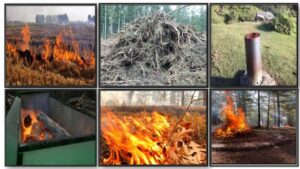Burn Permit Information
Burn Permits
Different types of burn permits may be required and/or issued by various authorizing entities in Santa Cruz County depending on the time of year as well as environmental conditions. This site will verify if the burn location falls within CAL FIRE designated areas. The types of CAL FIRE permits are described below. All CAL FIRE permits can be applied for online at burnpermits.fire.ca.gov.
Residential Burning:
Residential burning means the disposal of the combustible or flammable vegetative material from a single- or two-family dwelling unit or residence by burning outdoors. Residential burning is not agricultural, including prescribed burning. Residential Burning constitutes the burning of vegetation piles no greater than 4’ by 4’ by 4’ in diameter.
Residential Burning begins December 1st and ends on May 1st, annually.
Santa Cruz County Fire Code 7.92.307.2 provides authority governing Residential Burning.
Physical burn permits for Residential Burning are not issued by CAL FIRE in Santa Cruz County. Instead, the document Guidelines for Pile Burning outlines and defines the terms necessary to legally conduct a Residential Burn. Adherence to all terms outlined in the Guidelines for Pile Burning is the equivalent of possessing a burn permit. Any deviation to the outlined terms is the equivalent to burning absent of a permit and can face criminal and civil penalties.
Residential burn permits are required by Monterey Bay Air Resources District (MBARD) in Santa Cruz County.
Residential Burning Terms:
• Burning must occur on a permissible burn day. Burn status is determined by Monterey Bay Area Unified Air Pollution Control District, visit Burn Day Status (mbard.org) or call (800) 225-2876.
• You must contact your nearest CAL FIRE Fire Station before burning each day.
• Contact and obtain an Air District Burn Permit
• Fire may be ignited between 8:00 AM to 4:00 PM and must be completely out by 5:00 PM.
• Have adequate and functional fire tools onsite.
• Adequate water source to extinguish fire and potential escape.
• A responsible adult shall always be in attendance of the fire.
• A minimum clearance of 10-feet from all flammable material down to bare mineral soil must be provided and maintained.
• Burn only cured (dry) materials.
• Burn only natural vegetation. Do not burn processed or treated wood, plastic, metal, or trash.
• Burn only vegetative matter collected on permitted property.
• Do not burn on windy days or days with low relative humidity (Red Flag). Permits will be subject to wind, temperature, and humidity requirements.
• The responsible person must be always in possession of the burn permit.
• To report an escaped burn, call 911.
If larger burn pile size is needed or burning a 4’ by 4’ by 4’ burn pile on or after May 1st, then a General Burning permit is required.
Residential Burning is NOT permitted from May 1st to December 1st.
General Burning:
General Burn Permit (LE-5) allows Large Pile Burning and Planned Fire. This can include agricultural burning, burn piles, small parcels or strips, small plots of grass or weeds, or burn on vacant land. This permit is also used for a Hazardous Project work that could cause a fire (e.g., outdoor welding, grinding, metal work, hot work etc.).
A site visit is required before a permit is issued.

General Burn Permit Terms:
• Burning must occur on a permissible burn day. Burn status is determined by Monterey Bay Area Unified Air Pollution Control District, visit Burn Day Status (mbard.org) or call (800) 225-2876.
• You must contact your nearest CAL FIRE Fire Station before burning each day.
• Contact and obtain an Air District Burn Permit
• Fire may be ignited between 8:00 AM to 4:00 PM and must be completely out by 5:00 PM.
• Maximum permit duration is usually 2-weeks.
• Have adequate and functional fire tools onsite.
• Adequate water source to extinguish fire and potential escape.
• A responsible adult shall always be in attendance of the fire.
• A minimum clearance of 10-feet from all flammable material down to bare mineral soil must be provided and maintained.
• Burn only cured (dry) materials.
• Burn only natural vegetation. Do not burn processed or treated wood, plastic, metal, or trash.
• Burn only vegetative matter collected on permitted property.
• Do not burn on windy days or days with low relative humidity (Red Flag). Permits will be subject to wind, temperature, and humidity requirements.
• The responsible person must be always in possession of the burn permit.
• To report an escaped burn, call 911.
• Additional terms for specialized burning (e.g. curtain burners) may be required.
Processing the application can take up to 10-days. Be sure to provide adequate time for this process when scheduling your project.
Broadcast Burning:
Broadcast Burning is the controlled application of fire to the land to reduce wildfire hazards, clear downed trees, control plant diseases, improve rangeland and wildlife habitats, and restore natural ecosystems as outlined in Public Resources Code 4491-4494. This type of burning is sometimes called a controlled burn, prescribed fire, or prescribed burning and is one of the most important tools used to manage fire today. As catastrophic wildfires continue to be a growing concern in California, the use of prescribed burning to reduce hazardous fuels is projected to increase. Daily burn decisions are issued based on the forecast of air quality and meteorological conditions that can affect smoke dispersion. Certain types of projects may require CEQA approval. For more information check out the Prescribed Fires website.
Permit terms are dependent on the size and type of project. Contact CAL FIRE for more details.



